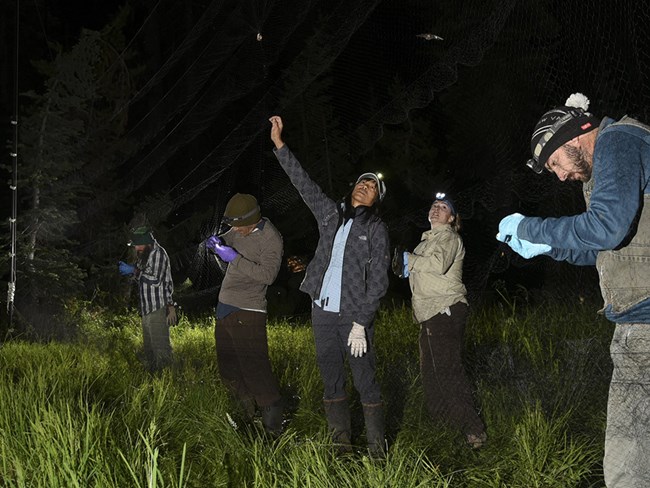Last updated: January 27, 2022
Article
Scientist Profile: Alice Chung-MacCoubrey, Biologist and I&M Program Manager

NPS / Alice Chung-MacCoubrey
Finding true passion on the road to the National Park Service
“I had a strong interest in wildlife when I was young, but didn't know it could be a career. I'm from the suburbs of Philadelphia and first-generation Chinese here in the US. I didn’t get much exposure to the outdoors and nature growing up, but am really appreciative that my parents dabbled in camping and took our family to see some of the amazing western landscapes and iconic national parks.
“I explored my interest in wildlife while pursuing my biochemistry degree at Rutgers University by volunteering on summer wildlife projects. In my senior year I took an elective course on forestry and wildlife conservation and was fascinated: it was the first class in my entire undergraduate career that I found interesting! That was a big eye-opener for me. But changing my degree would’ve delayed my graduation, so I finished my degree in biochemistry.
“After I graduated, my best friend and I volunteered on a North Atlantic right whale research project in Maine, where I also met my future husband Ian. After the project, I returned to work in a lab, but felt uninspired. Ian and I later took a cross-Canada trip on his motorcycle, during which I gathered my courage to make a career change and return to school for wildlife studies.

NPS / Andrew Lyons-Gould
“While taking classes at Oregon State University, I got into a Cooperative Education Program with the US Forest Service, which eventually led to a research scientist position at the Forest Service Rocky Mountain Research Station. I studied bats in New Mexico for my PhD, and that's really where I found my passion. I’ve been working with bats on and off for the last 26 years.
“While at research station, I took a Monitoring of Biodiversity course at the Smithsonian. That’s when I met some leaders in the National Park Service Inventory and Monitoring Program, and decided I belonged there. I started with the National Park Service as an I&M program manager at the Mojave Desert Network, then spent five wonderful years at Sierra Nevada Network, and finally came to the Klamath Network. I’ve been so incredibly privileged to have worked for so many amazing networks and parks; but I think I’m staying put now!

NPS
Alice’s work now: White-nose syndrome
“In addition to my duties as an I&M program manager, I’ve returned to working with bats because of white-nose syndrome, which showed up on the West coast in 2016. White nose syndrome is a deadly disease caused by the fungus, Pseudogymnoascus destructans (Pd), which is killing millions of bats across North America. I'm working to help understand the status of that disease in our geographic region.
“I feel fortunate to have been able to make contributions on this front. We made the first low-level detections of the fungus in California in 2018 and 2019 in a town called Chester. Now I’m working with staff at nearby Lassen Volcanic National Park, the California Department of Fish and Wildlife, Bat Conservation International, and Humboldt State University to find where two white nose-susceptible bat species, little brown myotis (Myotis lucifugus) and Yuma myotis (Myotis yumanensis), are roosting during the fall and winter. This information will help land managers understand how and where to focus white nose mitigation measures, and hopefully help us learn about how the fungus is moving through bat populations.
“One of the potential mitigation treatments that people are investigating now is the use of UV-C (short-wavelength ultraviolet) light to kill this fungus. But, in order to do that, you would have to expose other cave organisms to UV-C light. Cave ecosystems are complex and unique ecosystems, and bacteria are at the base of the food chain. Our network staff is working with Oregon Caves National Monument and Preserve, Lava Beds National Monument, University of New Mexico, and State University of New York to study the non-target effects of UV-C light on native cave bacteria. We're asking questions such as: How are cave bacteria communities affected by exposure to UV-C? How long does it take for them to recover? How effective is UV-C at killing the fungus that causes white-nose syndrome? Armed with answers to these questions, land managers will be in a better position to evaluate the use of UV-C to mitigate white-nose syndrome in their local bat populations.

John Chenger / Bat Conservation and Management
Alice’s personal lesson: Remaining mindful of purpose
“Back when I was developing my interest in wildlife and conservation, my purpose and passion for these topics were foremost in my mind. After 14 years as an I&M program manager, it’s easy to let a huge number of relevant, but less important and less inspiring, topics crowd my mind: budgets, agreements, deadlines, COVID news and guidance. So I have to make a concerted effort to get outside, take in the beautiful landscape of our parks around my home in southern Oregon, and re-connect with my purpose and passion. Doing that re-fills my cup, keeps my eyes on the prize, and gives me renewed energy to achieve my purpose!”
Interview and profile edited for brevity by Jeffrey Larooi, August 2020.
Additional Resources
Tags
- crater lake national park
- lassen volcanic national park
- lava beds national monument
- oregon caves national monument & preserve
- redwood national and state parks
- whiskeytown national recreation area
- nps careers
- science
- profile
- people
- bats
- ecology
- in the field
- klamath network
- klmn
- meet the scientist
- women in science
- stem
- nrss careers
- inventory and monitoring division
